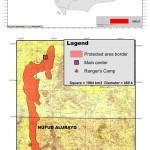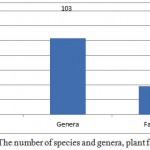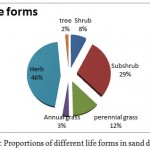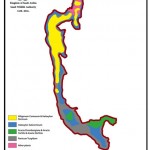Manuscript accepted on : 02 March 2017
Published online on: --
Plagiarism Check: Yes
Vegetation in Nafudal-‘Urayq Reserve of Saudi Arabia
Naif Meshal Al-Otaibi
Saudi Wildlife Authority, Riyadh, Saudi Arabia.
DOI : http://dx.doi.org/10.13005/bbra/2428
ABSTRACT:
Nafud al-‘Urayq is one of the smaller sand seas in the central Najd region of Saudi Arabia, representing the central Nafud Bioregion. It is a narrow dune corridor running north to south. After rains, Nafud al-‘Urayq is an extremely good scenic area, where the sand dunes contrast strikingly with the surrounding mountains.Nafudal-‘Urayq is a narrow corridor of dunes,located between Lat. 25° 00'N Long. 42° 29'Ewith a length of 145 km, and a width of about 7-30 km.The study area contains about 129 plant species belonging to 103genera in 38 families. Plant communities identified from the study area include Haloxylonpersicum-Calligonumcomosum, Haloxylonsalicornicum, Acacia ehrenbergiana-Acacia tortilis, Panicumturgidum and Artemisia monosperma communities. Majority of sand dunes are dominated by monostands of Haloxylonpersicum. Annuals other than psammophytes are found mostly in iselbergs and areas between dune depressions.
KEYWORDS:
Depressions; Flora; Haloxylonpersicum; Protected area; Sand dunes
Download this article as:| Copy the following to cite this article: Al-Otaibi N. M. Vegetation in Nafudal-‘Urayq Reserve of Saudi Arabia. Biosci Biotech Res Asia 2017;14(1). |
| Copy the following to cite this URL: Al-Otaibi N. M. Vegetation in Nafudal-‘Urayq Reserve of Saudi Arabia. Biosci Biotech Res Asia 2017;14(1). Available from: https://www.biotech-asia.org/?p=22978 |
Introduction
Sand seas in Saudi Arabia cover about one third of the interior which is divided into three major sand bodies, such as Great Nafud in the north, a crescent-shaped Ad Dahna in the middle, a vast land covering the entire south-eastern region, the Empty Quarter along with several small areas. Some of the earlier descriptions on the vegetation and topography of the central and northern regions including the sand deserts were given by Vesey-Fitzgerald (1957) and Schulz and Whiteny (1986). Topography and vegetation of interior sand deserts have not studied intensely by researchers except for some preliminary works covering the flora (Chaudhary, 1983). A preliminary work on major sand seas of Saudi Arabia was given by Al-Hemaid (1996). It contained a comprehensive list of species present in Rub Al-Khali, The Great Nafud, Ad Dahna and Al-Jafurah deserts. One of the main features of the vegetation cover of sand seas in central region is the poor plant diversity, though it is much higher than the average vegetation cover of other deserts in the country (Al-Nafie, 2003).
Nafud al-‘Urayq is a narrow sand dune habitat running north-south, and is representative of the Central Nafuds Bioregion.. The dunes are generally low, rising to a maximum of approximately 100 meters above the surrounding plain. The predominant plant community in the southern part of al-‘Urayq is composed of Haloxylonsalicornicum with scattered Calligonumcomosum.2,063.14 sq. km., including a core area of 10% (206 km2). The dunes are mostly well vegetated although some of the south-facing slopes are bare of vegetation. The predominant plant community in the southern part of Al-‘Urayq is composed of Haloxylonsalicornicum (Arabic rimth) with scattered Calligonumcomosum (Arabic arta). In the northern part, relatively dense stands of Haloxylon persicum (Arabic ghada) are found.”
“The local people are said to cooperate with the local authorities in the conservation of the ghada. This species has a trunk and rootstock that are highly valued as firewood, and is consequently under great pressure in many parts of the Kingdom.The sands appear to be heavily grazed by camels, although they do not show such severe signs of overgrazing as the surrounding plains. The nutritious perennial grass Panicum turgidum, for example, was found to be cropped lightly to moderately in Nafud al-‘Urayq, whereas on the plains it was often cropped to the ground in spite of its woody, unpalatable lower stalks.”
Materials and Methods of Work
The study area was visited several times by a number of teams but mostly by the author alone during spring months. Several quadrates with vegetation rich areas were selected for carrying out studies related to abundance and dominance of plant populations. Representative samples were collected, processed and stored at the Herbarium of Saudi Wildlife Authority and a duplicate set of specimens were also stored at the Herbarium (KSU) of Botany and Microbiology Department at King Saud University. Standard books (Mandaville, 1990; Chaudhary, 1999-2001, Collenette, 1999; Heemstra et al, 1990; Al-Hassan, 2006) and articles pertaining to the flora of Saudi Arabia were consulted for the correct Identification of the specimens recorded from the study area.
Study Area
Geology:Nafud al-‘Urayq is composed of Quaternary aeolian sand overlying the crystalline rocks of the Arabian Shield, which obtrude from the sands in crags of rhyolite in the south-central and northeastern parts of the reserve and in the granite inselbergs of Jabal ‘As‘as and JabalWasat on its southeastern edge.
 |
Figure 1: Location and physical features of Nafud al Urayq.
|
Topography:Nafud al-‘Urayq is a long, narrow sand sea, some 165 kilometers in length but only five to 15 kilometers in width. In the northeast mound shaped dunes predominate with an average relative height of 50 meters, while in the northwest, linear dunes of 50 meters are found. In the north-central part, the mound-shaped dunes decrease to 20 meters in height. Transverse dunes of 35 to 40 meters dominate the narrow central section while in the south the dunes rise to an average relative height of 75 meters. The lowest point in the reserve is the northernmost boundary at the edge of Wadiar-Rumah, while the highest point is the 1,395 meter summit of Jabal ‘As‘as. The reserve is comprised entirely of the sand sea with the exception of the high granite inselbergs of Jabal ‘As‘as and JabalWasat and the small plain between them and the sands, the rhyolite crags of Jabal al-Jafur, Jabal al-Jufayr, and JabalKhall at-Tayr, which obtrude from the sands in the south-central and northeastern parts of the reserve, some playas, and the seasonally flooded headwaters of Wadi al-Miyah on the southwestern edge of the reserve.
Climate
Average daily minimum& maximum summer temperatures between 1975 and 1984 is23.5°C and 40–41°C respectively. Average daily minimum& maximum winter temperatures between 1975 and 1984 are 7–8 °C and 21°C respectively. Annual rainfall is not recorded on the site as there is no climatic station present in the study area. However, the Climate Atlas between 1975 and1984 indicates that the region receives an average rainfall of 80–100 mm/year.
Water:Nafud al-‘Urayq lies within the drainage basin of Wadiar-Rumah, adjacent to the reserve’s northern edge. As a result of the permeability of the sands, there are no drainages of importance in the reserve, except for the seasonally flooded headwaters of Wadi al-Miyah on its southwestern edge. During periods of rain, water run-off the slopes of the granite inselbergs of Jabal ‘As‘as and JabalWasat and the rhyolite crags of Jabal al-Jafur, Jabal al-Jufayr, and JabalKhall at-Tayr, and run-off gathers in the playas of the reserve; these are mostly situated along the edges of the sand dunes in the southern part of the reserve, whereas north of Lat. 25° 00’N the playas fall outside the reserve boundaries. In the sands the capacity of the substrate to absorb and retain moisture means that significant rain can support vegetation for several years.
Soils: The General Soil Map shows Nafud al-‘Urayq as characterized by (52) Torripsamments: dunes more than 10 meters high, and in the southern part, less than 10 meters high (51). The isolated mountains are characterized by (39) rock outcrop–Torriorthents, surrounded by (20) Calciorthids–rock outcrop: plains of loamy, deep, saline soils and knolls and hills of rock. On the edges of the site are found (19) Calciorthids – rock outcrop: plains of loamy deep soils and knolls and hills of rock; (23) Calciorthids and Torriorthents – rock outcrop: loamy and loamy-skeletal, shallow soils and areas of rock; and (45) Torriorthents and Calciorthids–rock outcrop: loamy and loamy-skeletal, shallow and moderately deep soils and rock.
Results
Plant Diversity
The flora of the study area consists of 129 species belonging to103 genera in38 families (Fig. 2).The most common annuals are Blepharisciliaris and Horwoodiadicksoniae and perennials that spread high density areHaloxylonpersicum and H. salicornicum.
 |
Figure 2: The number of species and genera, plant families
|
Species Richness
A total of 129 species (see Appendix) were recorded from the dune areas, 75 species were reported during a trip to the red sand areas of the Great Nafud in April 1993 (Collenette&Tsagarakis, 2001).
Representation of Life forms
 |
Figure 3: Proportions of different life forms in sand dune areas
|
Fig. 3. Shows the proportions of life forms of the plants recorded. Annuals dominate the flora – annual herbs and annual grasses together comprise 61% of the species recorded. Such a high proportion of annuals clearly indicate that the compositional biodiversity will change dramatically with changing weather conditions. During the dry season or in times of drought, the vegetation would therefore be composed of a handful of species.
Based on the species recorded from the study area, majority of species have affinity towards Saharo-Arabian uniregionalphytogeographical zone, followed by a number of uniregional and pluri-regional zones, such as Somali-Masai, Saharo-Arabian-IranoTuranian, Mediterranean regions. Thus elements belonging to Saharo Arabian together with Mediterranean and IranoTuranian play a major role in the present floristic grouping of the study area.
 |
Figure 4: Vegetation Map of the study area
|
A primary visual observation has indicated the presence of five major communities in the study area, such as Haloxylonpersicum-Calligonumcomosum, Haloxylonsalicornicum, Acacia ehrenbergiana-Acacia tortilis, Panicumturgidum and Artemisia monosperma communities. H. persicum-C. comosum community is the most predominant community in the study area, mostly found in the northern part of Nafud Al-Urayq (Fig. 4). This community is characteristic of the deep sand, associated with several perennial components such as Moltkiopsisciliata, Panicumturgidum, Plantagoboissieri, Schismusbarbatus and Stipagrostisdrarii. Majority of associated species were found on the shoulders of sand dunes or shallow depressions. However, the presence of Calligonumcomosum is not prominent in most of the areas surveyed, probably due to the heavy use as a fuel-wood. The community dominated by Haloxylonsalicornicum was found along the periphery of the study area where deep sand do not occur. Associated species of this community are Polycarpaearepens, Citrulluscolocynthis, Convolvulus spp., Farsetiaglutinosa, Pulicariaundulata, Capparisspinosa, Helianthemumlippii, etc. Acacia ehrenbergiana-A. tortiliscommunity is found only in southern and southeastern part of the study area co-dominated by P. turgidum and H. salicornicum. Panicumturgidum community is mainly found in the southern parts of the study area associated with Acacia ehrenbergiana and A. oerfota. It is also often found along the fringes of northern borders. Overall H. persicum was found on calcareous crusts which were covered by older eolian sand, on dune slopes and interdune depressionswhereas H. salicornicumwas found at the bottom of the depressions. The presence of Tamaixaphylla trees in some depressions indicated the presence of shallow ground water just beneath the dunes. In certain places
Table 1: Appendix: List of Species Recorded from Nafud Al-Urayq.
| A- Annual ; P- Perennial; Pg- Perennial grass;H- Herb; T- Tree; S- Shrub; Ag- Annual grass; Ss- Subshrub | |||||
| Life Forms | Perennial Or | Species name | Family name | ||
| Annual | |||||
| SS | P | Blepharisciliaris | Acanthaceae | ||
| H | A | Aizooncaniariensa | Aizoaceae | ||
| H | A | Anisosciadiumlanatum | Apiaceae | ||
| S | P | Calotropisprocera | |||
| SS | P | Glossonemaboveanumssp.boveanum | |||
| SS | P | Glossonemavariens | Asclepiadaceae | ||
| SS | P | Pergulariatomentosa | |||
| SS | P | Anvilleagarcinii | |||
| H | A | Anthemisdeserti | |||
| H | A | Asteriscushierochunticus | |||
| H | A | Atractyliscarduus | |||
| H | A | Centaureabruguieriana | |||
| H | A | Centaureapseudosinaica | |||
| H | A | Centaurea sp. | |||
| SS | P | Echinopspolyceras | |||
| H | A | Filagodesertorum | |||
| H | A | Iflogaspicata | Asteraceae | ||
| H | A | Launaeacapitata | |||
| H | A | Launaeacassinica | |||
| H | A | Launaeanudicaulis | |||
| H | A | Picrisbabylonica | |||
| SS | P | Pulicariaincisa | |||
| SS | P | Pulicariaundulata | |||
| SS | P | Rhanteriumepapposum | |||
| H | A | Senecioflavus | |||
| H | A | Asphodelustenuifolius | Asphodelaceae | ||
| H | A | Asphodelusrefractus | |||
| H | A | Anchusaaegyptiaca | |||
| H | A | Arnebiahispidissima | |||
| SS | P | Heliotropiumbacciferum | Boraginaceae | ||
| SS | P | Heliotropiumdigynum | |||
| SS | P | Moltkiopsisciliata | |||
| SS | P | Trichodesmaafricanum | |||
| H | A | Diplotaxisacris | |||
| H | A | Eremobiumlineare | |||
| H | A | Horwoodiadicksoniae | |||
| SS | P | Farsetiaaegyptia | |||
| SS | P | Farsetiastylosa | |||
| SS | P | Morettiaparviflora | Brassicaceae | ||
| H | A | Savignyaparvtflora | |||
| H | A | Schimperaarabica | |||
| H | A | Zillaspinosa | |||
| SS | P | Gymnocarposdecander | |||
| H | A | Paronychia arabica | |||
| SS | P | Polycarpaearepens | Caryophyllaceae | ||
| SS | P | Sclerocephalusarabicus | |||
| H | A | Silenevillosa | |||
| SS | P | Capparisspinosa | Capparaceae | ||
| H | A | Cleome amblyocarpa | |||
| H | A | Bassiamuricata | |||
| SS | P | Aervajavanica | |||
| H | A | Bassiaindica | |||
| S | P | Haloxylonpersicum | Chenopodiaceae | ||
| SS | P | Haloxylonsalicornicum | |||
| SS | P | Halothamnusiraqensis | |||
| SS | P | Helianthemumlippii | Cistaceae | ||
| SS | P | Convolvulus buschiricus | |||
| SS | P | Convolvulus oxyphyllusssp.oxycladus | Convolvulaceae | ||
| SS | P | Convolvulus pilosellifolius | |||
| H | A | Citrulluscolocynthis | Cucurbitaceae | ||
| SS | P | Cyperusconglomeratus | Cyperaceae | ||
| H | A | Cynomoriumcoccineum | Cynomoriaceae | ||
| S | P | Ephedra foliata | Ephedraceae | ||
| H | A | Andrachnetelephioides | |||
| H | A | Euphorbia dracunculoides | Euphorbiaceae | ||
| SS | P | Euphorbia granulata | |||
| SS | P | Euphorbia retusa | |||
| H | A | Erodiumlaciniatum | |||
| Geraniaceae | |||||
| H | A | Monsonianivea | |||
| H | A | Monsoniaheliotropioides | |||
| T | P | Acacia raddiana | |||
| S | P | Acacia ehrenbergiana | |||
| S | P | Acacia tortilis | |||
| H | A | Astragalustribuloides | |||
| H | A | Astragaluscaprinusssp | |||
| SS | P | Astragalusspinosus | Leguminosae | ||
| H | A | Astragalusschimperi | |||
| H | A | Lotononisplatycarpa | |||
| H | A | Medicagolaciniata | |||
| SS | P | Sennaitalica | |||
| H | A | Ajugaarabica | Lamiaceae | ||
| SS | P | Salvia deserti | |||
| SS | P | Teucriumpolium | |||
| H | A | Gageareticulata | Liliaceae | ||
| H | A | Althaealudwigii | |||
| S | P | Hibiscus micranthus | Malvaceae | ||
| H | A | Malvaparviflora | |||
| H | A | Gisekiapharnaceoides | Molluginaceae | ||
| H | A | Neuradaprocumbens | Neuradaceae | ||
| H | A | Cistanchephelypaea | Orobanchaceae | ||
| H | A | Plantagoamplexicaulis | |||
| H | A | Plantagoboissieri | |||
| H | A | Plantagociliata | Plantaginaceae | ||
| H | A | Plantagoovata | |||
| PG | P | Aristidaadscensionis | |||
| PG | P | Aristidafuniculata | |||
| AG | A | Brachypodiumdistachyum | |||
| PG | A | Cenchrusciliaris | |||
| PG | P | Centropdiaforsskalii | |||
| PG | P | Chrysopogonplumulosus | Poaceae | ||
| PG | P | Cynodondactylon | |||
| PG | P | Enneapogondesvauxii | |||
| PG | P | Eragrostisbarrelieri | |||
| PG | P | Hyparrheniahirta | |||
| AG | A | Loliumpersicum | |||
| PG | P | Ochthochloacompressa | |||
| PG | P | Panicumturgidum | |||
| AG | A | Schismusbarbatus | |||
| AG | A | Stipacapensis | |||
| PG | P | Stipagrostisplumosa | |||
| PG | P | Stipagrostisciliata | |||
| PG | P | Stipagrostisdrarii | |||
| PG | P | Tetrapogonvillosus | |||
| PG | P | Stipagrostisobtusa | |||
| SS | P | Polygala erioptera | Polygalaceae | ||
| S | P | Calligonumcomosum | |||
| H | A | Emexspinosa | Polygonaceae | ||
| H | A | Rumexvesicarius | |||
| H | A | Cheilanthussp. | Polypodiaceae | ||
| S | P | Ochradenusbaccatus | Resedaceae | ||
| H | A | Reseda arabica | |||
| S | P | Kohautiacaespitosa | Rubiaceae | ||
| H | A | Haplophyllumtuberculatum | Rutaceae | ||
| S | P | Lyciumshawii | Solanaceae | ||
| T | P | Tamarixaphylla | Tamaricaceae | ||
| SS | P | Forsskaoleatenacissima | Urticaceae | ||
| H | A | Seetzenialanata | |||
| SS | P | Fagoniabruguieri | Zygophyllaceae | ||
| SS | P | Fagoniaglutinosa | |||
Annual cover is exceptionally high in the study area. About 46% of the flora was represented by herbs which were found in almost all places except in moving sand dunes. Majority of annuals appear after a sporadic showers during winter and spring and cover varies from sparse to dense. However, if the rain is not sufficient, herbs do not remain in the field for a longer period. Towards the middle and southern parts the lower and middle parts of the dune slopes support a vegetation cover dominated by diffuse perennials such as Stipagrostisdrarii, Cyperusconglomeratus and occasionally a few Calligonumcomosum whereas in areas with traces of moisture, the sand is covered by geophytes and mesophytes such as Eremobiumlineare, Filagodesertorum, Moltkiopsisciliata, Monsonianivea, Neuradaprocumbens, etc.
Discussion
Nafud Al-Urayq is the only sand sea in the central and northern parts of Saudi Arabia that lies completely on the Arabian Sheild (Watts and Al-Nafie, 2003). The sand of Nafud Al Urayq act as a vast reservoir of seeds of several species, particularly of annuals. Study area lies within the westerly depressions’ path crossing across Arabia and bring in rain during winter and spring season (Vesey-Fitzgerald, 1957). Seepage of water during heavy rains is well in most of the dune areas and remain there as reservoirs. However, moisture from light showers does not go down beyond 10 cm. These moisture either dries off quickly or taken by ephemerals and grass species with abundant root hairs with mucilage coatings (Chaudhary and Jowaid, 1999).There are several remarkable features of plant life in the sands. About 95% of the study area is covered with sand, which has relatively good textural and moisture-storing properties compared to some desert soils of adjacent areas (Mandaville, 1986) and providing niches for majority of psammophites. However, the growth of plants with relatively short root systems is negatively affected, primarily due to mobile dunes and poor water holding capacity of top soils in some parts. Plants with longer roots can survive well in the desert because water percolation and sand displacement is high and moreover, the water from meager rainfall is being stored in the deeper layers of sand. Among the stands studied highest diversity was observed in the rocky hummocks situated in the southeastern part of the study area and represented by species such as Aervajavanica, Centaureabruguieriana, Ephedra foliata, Erodiumlaciniatum, Forsskaoleatenacissima. Rhanteriumepapposum, etc. Population of Calligonumcomosum is in a highly degraded state, primarily due to excessive collection for fire wood. This plant is often overwhelmed with loose sand, therefore only the finer twigs appear above the summit of the mound.
Conclusions
Nafud al-‘Urayq is an extremely scenic area, where the sand dunes contrast strikingly with the surrounding mountains and after rains. Nafud al-‘Urayq is one of the smaller sand seas in the central Najd region of Saudi Arabia, a narrow dune corridor running north-south, and is representative of the Central Nafuds Bioregion. The predominant plant community in most of the areas of Al-‘Urayq is composed of Haloxylonsalicornicum, H. persicum with scattered populations of Calligonumcomosum.
Acknowledgements
The author is highly indebted to Dr. Jacob Thomas, Curator, Herbarium (KSU) at King Saud University for valuable comments and help in the identification species. The author is also thankful to the authorities at the Saudi Wildlife Authority in Riyadh for moral support and the Rangers at the office at the protected site for all support during the course of this research.
References
- Al-Fredan M. A. Sand dune and sabkhavegetations of eastern Saudi Arabia. Int J. Bot. 2008;4:196-204.
CrossRef - Al-Hemaid F. M. Vegetation and distribution of the sand seas in Saudi Arabia. Geobios. 1996;23:2-15.
- Al-Yemeni M. N. Ecological studies on Sand dunes vegetation in Al-Kharj region, Saudi Arabia. Saudi J. Bio. Sci. 2000;7(1):64-87.
- Chaudhary S. A. Vegetation of Great Nafud. Saudi Arabian Nat. Hist. Soc. 198;2:32-33.
- Chaudhary S. Flora of the Kingdom of Saudi Arabia. Ministry of Agri. & Water, Riaydh. 1999-2001;1-3.
- Chaudhary S. A & Al-Jowaid A. A. Vegetation of the Kingdom of Saudi Arabia. Ministry of Agriculture and Water, Riyadh. 1999.
- Collenette I. S. Wildflowers of Saudi Arabia. National Commission for Wildlife Conservation, Riyadh. 1999.
- Collenette S & Tsagarakis C. Some Regional Botanical Lists from Saudi Taif: NWRC. 2001.
- Llewellyn O. The Protected Area System in the Kingdom of Saudi Arabia: Revised Plan (draft). Riyadh, Saudi Arabia: Saudi Wildlife Authority. 2013.
- Al-Hassan H. O. Wild plants of the Northern Region Camel and range research center in collaboration with FAO, Al-Jouf. 2006.
- Heemstra H. H., Al-Hassan H. O & Al-Minwer F. S. Plants of northern Saudi Arabia.Range and Animal Development Research Center, Sakaka, KSA. 1990.
- Mandaville J. P. Flowers in the sand (Saudi Arabia). ARAMCO. Wld. Mag. 1968;19(1):23-25.
- Mandaville J. P. Plant life in the Rub’ al-Khali (the Empty Quarter), south central Arabia. In: I. C. Hedge (ed.). Plant Life of south west Asia. Proc. Roy. Soc. Edin. Sect. B. 1986;89:147-157.
- Phillips J. A. The red sands of the Arabian desert Geol. Soc. of London. Quarterly J. 1882;38:110-113.
- Watts D and Al-Nafie A. H. Vegetation and biogeography of the sand seas of Saudi Arabia. Kegan Paul, London. 2003.
- Whitney J. W., Faulkender D. J & Rubin M. The environment history and present condition of the Northern sand seas of Saudi Arabia. Ministry of Petroleum and Mineral Resources, Jiddah, Saudi Arabia. 1983.

This work is licensed under a Creative Commons Attribution 4.0 International License.





